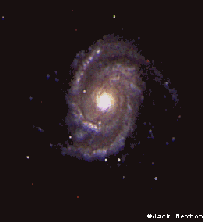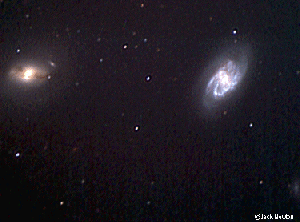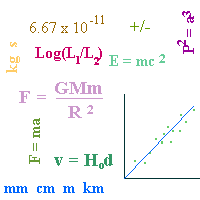If necessary, review the section on scientific notation. Work the following problems first on paper, and then using a calculator. If you do not own a calculator that uses scientific notation, then find someone who does and borrow it.
- Multiply: 3.1 x 107 by 3 x 105
- Multiply: 1.496 x 1011 by 5.2
- Divide: (6.4 x 106)2 by 6.7 x 10-11
The term "error" signifies a deviation of the result from some "true" value. Often we cannot know what the true value is, and we can determine only estimates of the errors inherent in the experiment.
If we repeat the experiment, the results may differ from those of the first attempt. We can express this difference as a discrepancy between the two results. The fact that a discrepancy arises is due to the fact that we can determine our results only within a given uncertainty or error. The more precise our measuring tool, the more precise our answer; the more accurate our input data, the more accurate our results. But, we will always have some uncertainty.
- As a simple example, find the wavelengths (in nm
or 10-9 meters) of the blue, yellow, and red lines in
the following figure?

- Wavelengths:
- What is the uncertainty in your answer? That is,
how far off (in nm) could your determinations be?
- How could you make your answer more precise?
- Now, use a ruler to measure the distances between
the blue and yellow lines, yellow and red lines, and
blue and red lines. (You can do this directly from the
screen; watch out for a parallax effect.)
Write those measurements (in cm or mm here.
Include your uncertainty for each measurement. For example,
4.5 cm +/- 0.05 cm:
- Determine a rough "scale factor" or "plate
scale" by dividing the difference in wavelengths between
two colored lines by the distance in cm or mm (the units
will be nm/cm or nm/mm. For example,
if you estimated the yellow line wavelength at 510 nm and
the blue line wavelength at 425 nm, the difference in
wavelength is 85 nm. You measure a difference of 29 mm
(+/- 1 mm). The scale factor would be 85nm/29mm, or
2.9 nm/mm. Do this for at least 3 different pairs of
lines, average your results, and write your scale factor
here:
- If you had a friend measure the distances,
would her/his results differ from yours? Why or why not?
In science, we can never hope to have absolute precision, absolute accuracy. It is perfectly acceptable to have large uncertainties, as long as we let the reader know our estimate of those uncertainties so that an intelligent evaluation of the results can be made. As scientists, we strive to perfect our experiments and observations in order to improve the precision and accuracy of our results.
- Wavelengths:
- I have used both terms "accuracy" and "precision." These
two words do not mean the same thing. How does an "accurate"
measurement differ from a "precise" measurement?
- An astronomer has considerable leeway in setting the criteria for her/his
observations and the interpretations of those observations. For example,
astronomers may assume that if they see two morphologically similar galaxies,
these galaxies are similar in actual size. Therefore, if one of the
galaxies appears to be one-half the size of the other, then
the "smaller" galaxy is twice as far from us.
Measure the diameters of the following three, similar (but not identical) galaxies (from "The Ultimate CCD Collection" by Don Parker and Jack Newton):

|

|
- What criteria did you use when determining each diameter?
- In determining the relative distances of these galaxies:
- Would it matter if you used a different criterion
for measuring each galaxy? Why or why not?
- Would it matter if one of your class mates used different criteria
than you did? Why or why not?
- Would it matter if you used a different criterion
for measuring each galaxy? Why or why not?
- Distances
- Which galaxy is the nearest? Farthest?
- How much farther away from us is the farthest galaxy compared
to the nearest?
- What assumption (stated above) is necessary for you to feel
confident your answer is correct?
- Which galaxy is the nearest? Farthest?
We use an absolute minimum of statistics in this class. You are probably very familiar with the terms "mean" and "standard deviation" from your high school math as well as from large lecture classes here where the grades are based on a curve.
If we have enough data, we may wish to graph the observations and see if there is a relationship between the variables. For example, one can plot the magnitudes (brightness) of the stars on a planisphere against the sizes of the dots representing those stars. Here are measurements for five stars from the Edmund Scientific Star and Planet Locator:
| Star Name | Diameter (mm) | Magnitude |
|---|---|---|
| Sirius | 2.7 | -1.5 |
| Arcturus | 2.1 | 0.0 |
| Procyon | 2.0 | 0.4 |
| Fomalhaut | 1.8 | 1.2 |
| Adhara | 1.5 | 1.5 |
- Using a piece of graph paper, plot the magnitude (brightness) of the
star against its size.
- Draw a straight, best-fit line through
the data points. This means, draw a line that has approximately
just as many data points above it as below it. Since these are
real measurements, and each measurement has an error (I estimate
+/- 0.2 mm), it would be a rare occasion indeed if the data formed
a perfectly straight line.
- Find the slope of this line. That is, find
the change in y divided by the corresponding
change in x.
- What is the slope of the line?
- Does the equation, y = mx + b seem familiar?
- Do you see that for all future measurements, all we need to
do is measure the size of the star and use our relationship to
find the corresponding magnitude?
- What is the slope of the line?
If we have a large number of observations of the same thing,
- we expect the mean value to be at least near to the true value.
- we can find this mean value by totalling all values and dividing by the number of values.
- we can regard any deviation from the mean as an error.
The guidelines for significant digits are:
- Carry one or two non-significant digits through all calculations.
- Round the final answer to the required number of significant digits.
- The number of significant digits will be that of the value having the smallest number of significant digits.
- How many significant digits are in the following numbers?
- 1.5
- 3.5689
- 4000
- 3.68
- Multiply 1.5, 3.5689, 4000, and 3.68. Round your answer to the correct number of significant digits.
Did you get 80,000? If not, check out the math review on significant digits (which will also give you the answer to the "precise vs. accurate" question above).
